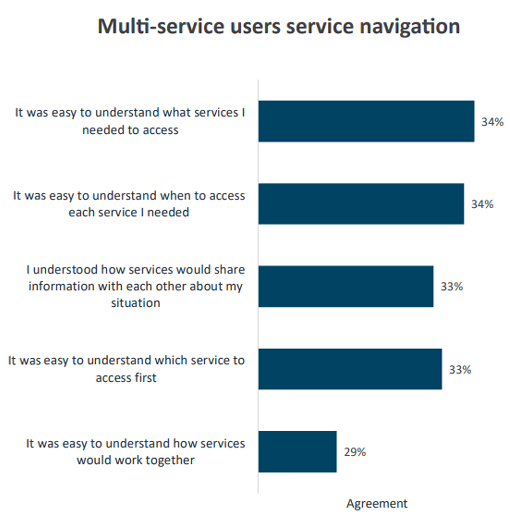People experience many life events such as having a baby or entering the workforce. When people experience these life events, they may have a reason to access Australian public services.
This section focuses on whether people during these life events access one service or multiple services for the same reason.
A focus is placed on single service users (people who use one service for a reason) versus multi-service users (people who access two or more services for the same reason).
Who did we survey?
- Single Service User: 37%
- Multi-service User: 32%
- 2 Services: 18%
- 3+ Services: 14%
Access
Only a third of multi-service users know the way to access services.
Effort
People report more effort the more services they access.
Desire for change
Multi-service users have a greater desire for change in the future.
Only a third of multi-service users know the way to access services
Navigating services can be complex
Slightly over a third of those accessing multiple services for the same reason know what services they need to access and when to access them.
This understanding is lower for respondents who access three or more services compared to those who access two services.
Understanding how different services work together was also lower for those accessing three or more (25%), compared to those accessing two (32%).

The system is complicated... They do not tell the whole story just bits of it. I have to ask more information about every process and for help needed.
People report more effort the more services they access
More services, more effort
A third (33%) of those accessing two services reported it took a lot of effort to access and receive services.
This increases to 38 per cent for those accessing three or more.
Repeating the same information to multiple agencies was particularly high for those accessing three or more services (36%), compared to those accessing two (26%).
More services, more channels
Single and multi-service users primarily use one channel to engage services.
A higher proportion of multi-service users report using more than one channel.
Twenty-two per cent of multi-service users report using three or more channels to engage a service.
While myGov is the channel used most, multi-service users also have higher use of phone calls, smartphone apps and APS websites when compared to single service users.
Multi-service users also highlight a greater desire to change the way they interact with services. One fifth of multi-service users would change the way they interact in future, compared with just 13 per cent of single service users.

I think the people who work there are generally honest but there can be long waiting periods and different organisations don't 'talk' to each other.
Multi-service users have a greater desire for change in the future
More services, more feedback
Multi-service users (particularly those using three or more services) provide feedback more often than single service users (24% versus 17% ).
Multi-service users (particularly three or more service users) also submit more complaints (28%).
Multi-service users accessing three or more services report both greater satisfaction (35%) and greater dissatisfaction with how their feedback is handled (23%) when compared with those using one or two services.
More services, more desire for change
Although trust in Australian public services does not greatly differ between single and multi-service users, the desire for future change and trust in this change does.
A third of single service users agree Australian public services need to change in the future to meet the needs of all Australians, and 25 per cent trust Australian public services to implement those changes.
In contrast, almost half of multi-service users think Australian public services need to change in the future (45%), but just over a quarter trust Australian public services to implement those changes (27%).
Those services I've used for the most part are good. However, the teams of people strike me at times to be bureaucratic, they need to be more proactive, more anticipating, better questioning & self reliant.
Citizen Journey Case Study
Amy (38) has started a new job.
She needs to update her income details with the ATO. which also affects current payments from Centrelink.
Amy and her child have also moved house, meaning she needs to update her details in myGov for Centrelink and Medicare.
Amy supports her child who has a disability. She is seeking support from the National Disability Insurance Scheme (NDIS). and uses Medicare and the Pharmaceutical Benefits Scheme (PBS) for her child.

